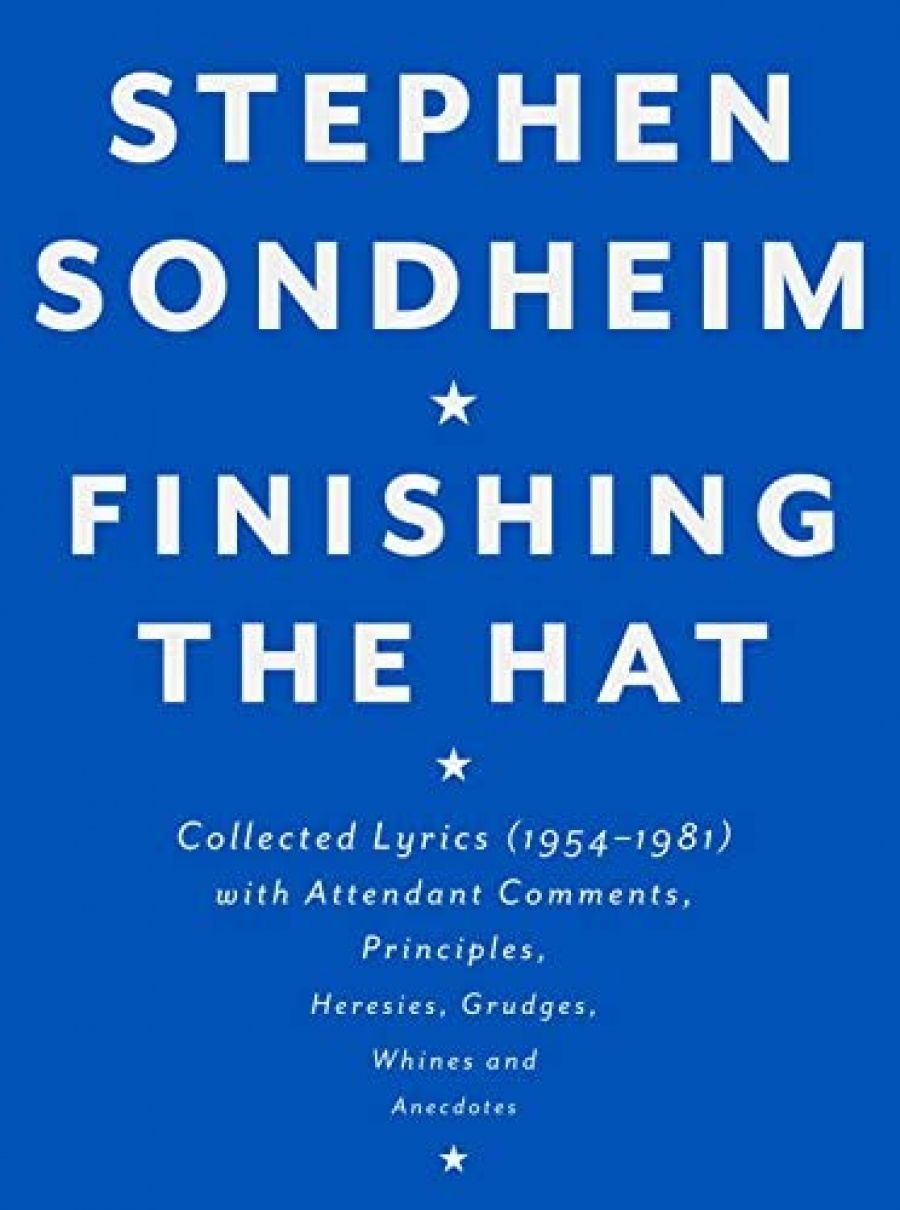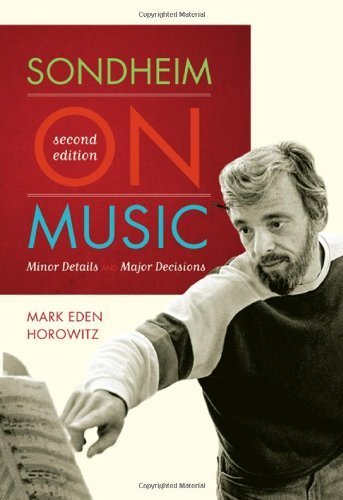
- Free Article: No
- Contents Category: Theatre
- Review Article: Yes
- Online Only: No
- Custom Highlight Text:
Given Stephen Sondheim’s well-known fondness for verbal games and puzzles (as a diversion from his day job, he has devised crossword puzzles for the New York Times), it seems appropriate to begin this review with a short quiz based on some of the ‘attendant comments and grudges’ referred to in the subtitle of, and dotted throughout, Finishing the Hat. Match the author’s critical judgements to the selected lyricists listed below:
- Book 1 Title: Finishing the Hat
- Book 1 Subtitle: Collected Lyrics (1954–1981)
- Book 1 Biblio: Virgin Books, $69.95 hb, 472 pp
- Book 2 Title: Sondheim on Music
- Book 2 Subtitle: Minor Details and Major Decisions, Second Edition
- Book 2 Biblio: Scarecrow Press, £31.95 hb, 568 pp
- Book 2 Cover Small (400 x 600):

1.‘[He ]is the laziest of the pre-eminent lyricists, and one of the most disconcerting … [his] laziness manifests itself in three areas: mis-stressed syllables, convoluted syntax and the sacrifice of meaning for rhyme.’
2.‘The Master of Blather … Even [his] jabs at being jazzy and contemporary are innately condescending when they’re not simply embarrassing in their attempts to be “with it” …’
3.‘This lyric is another example of the difference between funny and clever. The two … stanzas … are a form of literary masturbation and too clever by half, a phrase British critics are fond of overusing.’A.Tim Rice; B. W.S. Gilbert; C. Lorenz Hart; D. Nöel Coward.
Answers: 1C; 2D; 3 – well, I cheated here. The correct answer is ... Stephen Sondheim.
Such an unapologetically dismissive comment might perhaps be seen as taking self-abuse a touch too far: but it is of a piece with the author’s approach throughout this unfailingly engaging, provocative, and instructive promenade backstage, together with the sharp-eyed examination of the archaeological layers that make up the writer’s desk. The book takes in thirteen works, beginning with Saturday Night from 1954, and continuing on past such permanent signposts as West Side Story and Company, up to Merrily We Roll Along in 1981. While the author may open with a disclaimer – ‘a printed collection [of theatre lyrics] is a dubious proposition ... Lyrics, even poetic ones, are not poems’ – the range of styles, imagery, and tone, together with the virtuoso handling of rhythm and metre, give the lie to such diffidence.
Even readers not inclined to value the American musical for its extraordinary contribution to twentieth-century theatre history will still find much to engage their interest in these pages: from Sondheim’s views on poetry and poets, through the relationship between text and music, and taking in some wholly deserved sideswipes at academics, theatre critics, and former collaborators.
Not that any of these whines are in the least mean-spirited: with typical attention to (semiological) detail, the author has ensured that the typeface for the attendant six categories of the subtitle diminishes in size from the central Comments down to the footnote-size Anecdotes. And while none of the latter is either irrelevant or uninstructive, most are also either wonderfully droll or laugh-out-loud funny. Take, for instance, the priceless detail that Elaine Stritch (for whom the number ‘The Ladies Who Lunch’, the definitive showbiz anthem celebrating the joys of the Manhattan version of dolce far niente, was written) asked Sondheim what kind of pastry the words ‘perhaps a piece of Mahler’s’ referred to; or the description of Jerome Robbins, displaying ‘characteristical sullenness’ when ‘he felt someone was trying to put something over on him’ during a discussion of the number from Gypsy, ‘Everything’s Coming up Roses’: ‘But her name is Rose … I mean, everything’s coming up Rose’s what?’
The Pythonesque preposterousness of Robbins’s querulousness is neatly offset by Sondheim’s postscript to the discussion: ‘I promised him fervently that if anyone else was ever confused by the coincidence of “Rose” and “rose” that I’d find another title. No one did, and I was able to retain my triumph.’ Along with Sondheim’s mentor Oscar Hammerstein and collaborators Hal Prince and Arthur Laurents, the figure and personality of Jerome Robbins looms large over many pages of this book. As others have attested, he was far from easy to deal with, and many of Sondheim’s descriptions of working with him reinforce this perception, while incidentally prompting the reader’s admiration for Sondheim’s ability to roll with the punches.
One of their earliest exchanges, at the time of West Side Story, comes when Sondheim plays ‘Maria’for him for the first time. Robbins’s only comment is: ‘What’s Tony doing?’ When Sondheim tries to explain that Tony is singing about a girl he’s just met, Robbins replies: ‘No, what’s he doing onstage?’ Further attempts at explanation from the young lyricist are equally unproductive, and lead to Robbins finally snapping: ‘Okay, you stage it.’ Later, we find him folding his arms, shutting his eyes, and shaking his head at every argument concerning the placing of the Quintet in Act One, objecting to Bernstein’s supervised orchestration of ‘Somewhere’ and actually ‘dictating the alterations he [wants] directly to the conductor and musicians’.
It takes a certain resilience to cope with this sort of directorial megalomania. What is revealing about Sondheim’s recounting of such incidents is not simply that, implicitly, they provide evidence of his own commitment to the collaboration, but that he explicitly spells out the underlying reasons for putting up with Robbins’s displays of – what shall we say? – temperament. In the case of the Quintet, we learn that ‘as you might guess, Jerry turned out to be right’; that, in the case of the re-orchestration, Bernstein ‘could not stand confrontation any more than I could, particularly with Jerome Robbins … It may be one of the reasons Lenny was so loved. And Jerry so hated’; finally, that, to come up with an outline for ‘Rose’s Turn’ from Gypsy, the ‘three hours spent alone with Robbins in a deserted, ghost lit auditorium … with a man I considered a genius’ led to a number that occupies a place in that musical (and in the pageant of the American musical) analogous to a Shakespearian monologue (my comment, not Sondheim’s).
But while Sondheim’s portrait of Robbins offsets his criticisms with an acknowledgment of his theatrical insights, he is by no means so generous in his comments on certain critics and academics. And rightly so. Among the most amusing pages of this book is his account of working with Robert Brustein, then director of the Yale Rep, as well as a critic, teacher, and essayist. Criticising Brustein might be seen in certain American academic circles as rather like defacing the Lincoln Memorial (at least in its subject’s view). Having once had the misfortune to encounter at a conference this preening pontificator on all matters theatrical, I must confess that Sondheim’s devastating indictment of working with Brustein (‘one of the few deeply unpleasant professional experiences I’ve had, largely because it was so unprofessional’; ‘I knew about Brustein’s arrogance; what I underestimated was his ambition’) caused waves of such intense Schadenfreude that I had to put down the book and listen to ‘I’m Calm’ (from A Funny Thing Happened on the Way to the Forum) for at least an hour.
Such incidental pleasures are balanced, however, by the other more essential contributions the book makes to understanding the sheer professionalism and technical skill that Sondheim brings to the craft of lyric writing. Dotted throughout the pages are photocopies of Sondheim’s drafts of alternative lines and rhymes for various songs: most lyricists would be shaking their heads in despair at the richness of invention for readings that don’t make their way into the final version. Between pages 84 and 85, for example, there are linked (and subsequently discarded) patterns for ‘Comedy Tonight’ that are just as memorable as the final versions. How about ‘young men eloping / old men still hoping’; or ‘virgins and lechers / corpses on stretchers’? And, on the other hand, how right he was to discard ‘Sophocles on Monday / Plautus tonight’: an unwieldy antithesis compared with the final ‘tragedy tomorrow / comedy tonight’.
If there is one aspect of Sondheim’s work processes that receives not quite so much attention, it is the specifically musical: but then, in a sense, this goes beyond the book’s main aim, which is the concentration on the words and the lyricist’s approach. Although Sondheim has general things to say about music and other composers (his two favourites are Harold Arlen and Jerome Kern), it is to Mark Eden Horowitz’s study that one must turn to find a more thorough engagement with questions such as musical language and structure and compositional influences.
Along with analyses of chord structures and harmonies, and many well-chosen notated examples, Horowitz has expanded the original version of this study with two new chapters and a list of songs Sondheim wishes he had written. Part III, devoted to song listing, discography, and publishing information, is an indispensable guide and research tool. (There is also a significant Australian connection: according to Horowitz, it appears that the first-ever Sondheim album featuring a solo artist performing his songs was Geraldine Turner’s LP from 1986.)
In the extended interviews with Sondheim, Horowitz’s intelligent, probing questions prompt responses that throw light on everything from his admiration for a work not widely known to most listeners (Gösta Nystroem’s ‘Sinfonia del Mare’, a piece Sondheim urged me to listen to when I met him), and which he confesses has left its mark on half the music that he has written, through to the observation that, apropos lyric writing, ‘there isn’t that much to say’.
Happily, as Finishing the Hat demonstrates, Sondheim seems to have either forgotten or ignored the remark. What’s more, this particular hat is far from finished: the book reaches not a conclusion but what its author terms an Intermission. Even those (misguided) critics who believe Sondheim cannot write second acts should be looking forward to the follow-up, which will feature not just the masterpiece in which the number ‘Finishing the Hat’ occurs, but also my own personal favourite among Sondheim’s works: that take on not only Annie, but everyone from John Wilkes Booth to Lee Harvey Oswald, getting their gun – Assassins.


Comments powered by CComment